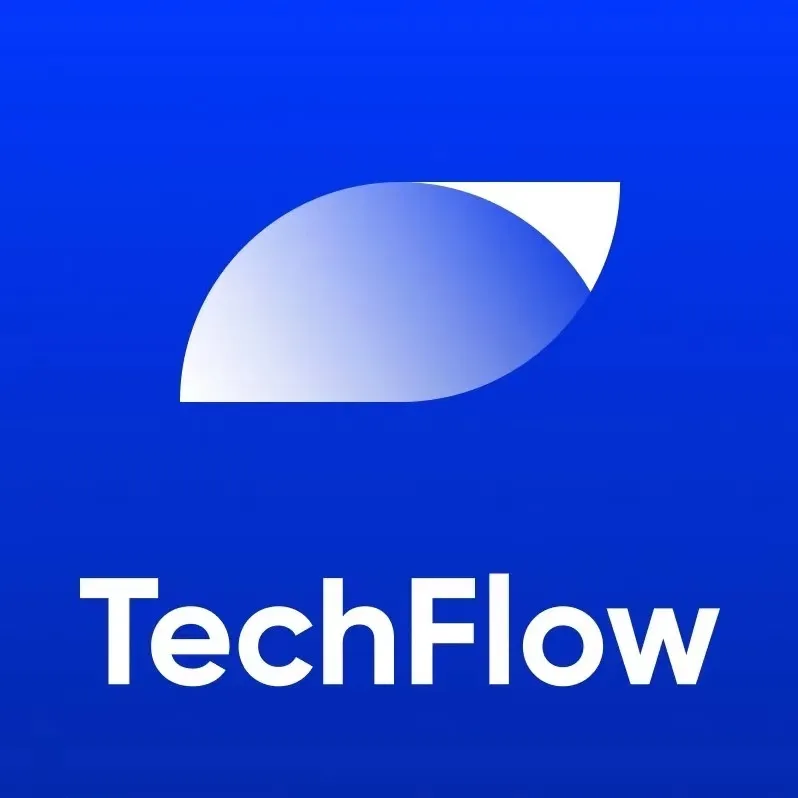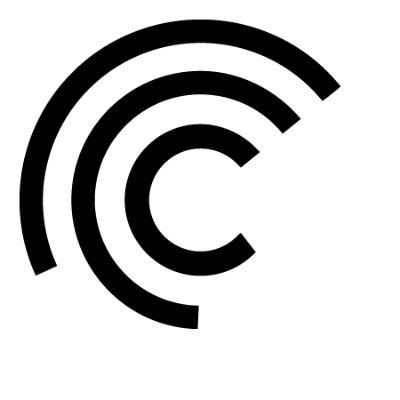On-chain RWA Report: US Treasuries Drive Yield Growth, A Few Crypto-Native Users Lead Track Demand
Original Title: 《Overview of On-Chain RWAs and the Forces Propelling their Growth》
Written by: Zack Pokorny
Compiled by: Deep Tide TechFlow
There are several different RWAs on the blockchain, each with its own characteristics, serving different use cases. While certain types of RWAs, such as stablecoins and tokenized gold, have existed for years, other types of RWAs, such as U.S. Treasury bonds, have recently emerged against the backdrop of rising interest rates. This article will briefly outline the following types of income-generating RWAs:
- Real Estate
- Private Credit
- Treasury Bonds
Note: The following analysis focuses on these tokenized assets and their market capitalization. This report does not include information about the underlying protocols for building RWAs (such as Ethereum, Polygon, Stellar, etc.) or ancillary blockchain-native services that support RWA trading and financial management. Additionally, the report will not involve stablecoins in charts and RWA TVL calculations (which hold the largest market share at $125 billion and are the longest-standing RWAs) to avoid overshadowing the growth of smaller market cap RWAs or underestimating the driving forces behind RWAs.
Integrating the Real World with the Digital World
RWAs are created by issuers who complete one or more of the following activities:
Acquiring assets in the real world
Tokenizing these assets on-chain
Distributing RWA tokens to on-chain users
Without issuers—whether they are centralized companies, decentralized protocols, or a combination of both—RWAs would not exist on-chain.
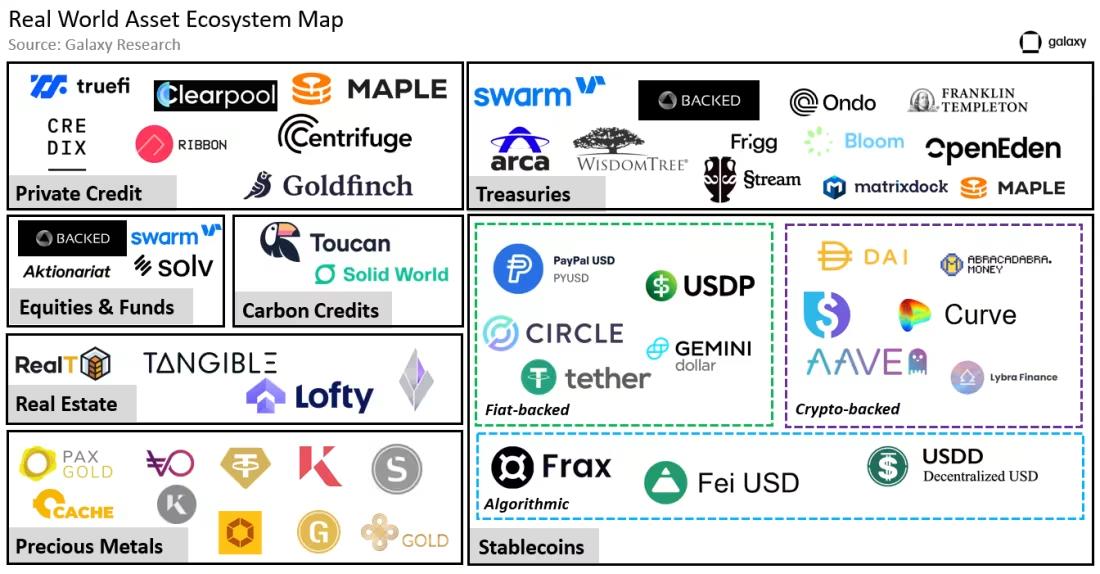
Notable RWA issuers include:
- Centrifuge (active issued RWA value of $238 million) ------ the largest on-chain private credit lender.
- Franklin Templeton (active issued RWA value of $310 million) ------ a traditional financial institution issuing tokenized Treasury bond tokens.
- Wisdom Tree (active issued RWA value of $11 million) ------ an institutional capital market issuing Treasury tracking funds.
This brief list, along with other issuers shown in the image above, highlights the situation where off-chain entities back on-chain RWAs. Franklin Templeton and WisdomTree are two seasoned traditional financial companies whose main businesses are unrelated to cryptocurrency and blockchain technology. Franklin Templeton is a global investment firm with a 76-year history, providing mutual funds, ETFs, and other fund products to individuals and institutions. As a company, Franklin Templeton manages over 100 ETFs and mutual fund products, with total assets under management of $15 trillion. WisdomTree is a global financial innovation company founded in 1985. The company offers a diverse range of exchange-traded products (ETPs), models, and solutions. WisdomTree manages total assets of $95.948 billion.
In recent years, Franklin Templeton and WisdomTree have begun experimenting with RWAs by tokenizing various traditional financial instruments such as tokenized equity funds and Treasury bonds to meet the needs of institutional clients. Although these efforts are still in their early stages, the actions of traditional financial companies issuing RWAs have the potential to catalyze a large influx of new users who have never interacted with the blockchain into cryptocurrency.
Growth of Income-Generating RWAs
As of September 30, the market capitalization of RWAs reached $2.49 billion, down 9.6% from the peak of $2.75 billion on April 19. Despite strong growth in Treasury-related RWAs, the active loans from private credit issuers have significantly decreased over the past 18 months, causing the RWA market capitalization to fall below its historical high.
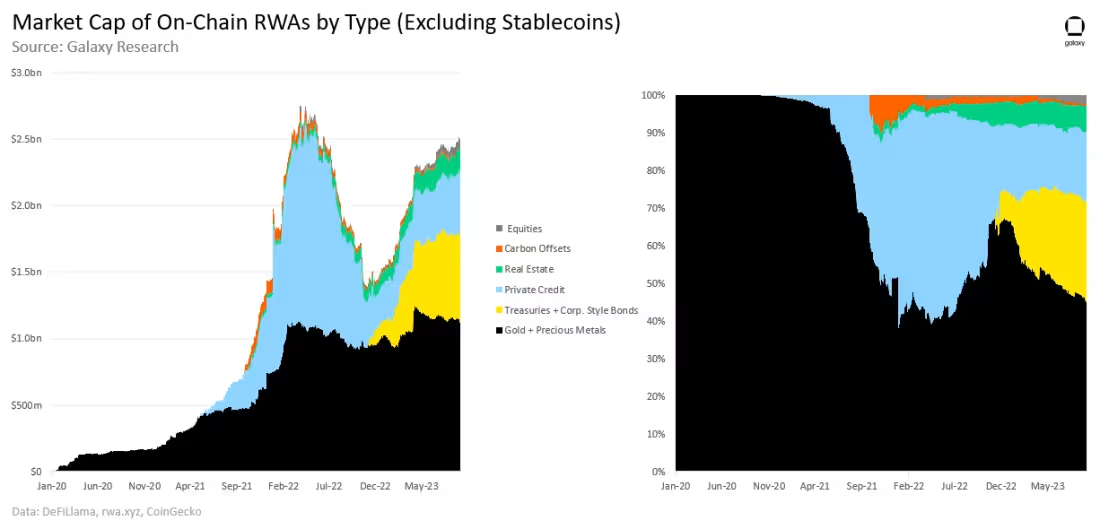
From January 31 to September 30, the value of non-stablecoin RWAs increased by $1.05 billion. The new growth of $855.7 million over the past three quarters came from Treasury bonds and other bonds, real estate, and private credit.

Private Credit
Private credit is a form of lending provided by non-bank institutions. Since the 2008 financial crisis, the private credit market has seen significant growth as banks face increasing regulation and borrowers seek alternative sources of capital. This trend has further expanded in the current interest rate cycle, particularly as bank balance sheets are constrained (as evidenced by bank failures earlier this year). Private credit solutions benefit both borrowers and lenders. They provide borrowers with the flexibility lacking in bank loans; their floating rates offer interest rate protection that fixed-rate alternatives do not. As of August 2023, the global private credit loan market is valued at $15 trillion.
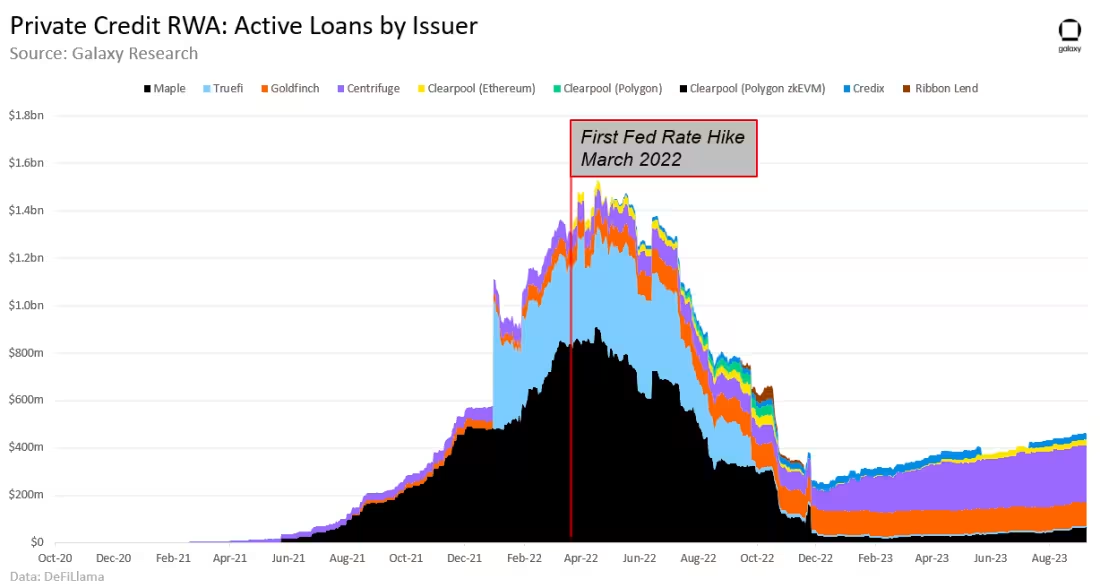
From January 1 to September 30, the active value of on-chain private credit loans increased by $210.5 million (an 84% increase). Most of the growth (74%) came from Centrifuge, which saw its outstanding loan balance increase by $155.7 million. The decentralized credit market Clearpool experienced the largest relative change over the past three quarters. From January 1 to September 30, the platform's loan balance grew by 966%, reaching $23.96 million by September 30. Clearpool has issued over $400 million in private credit loans across three chains (Polygon, Polygon zkEVM, and Ethereum) during its lifetime.
Despite growth in 2023, the total value of on-chain private credit loans remains 70% lower than the historical high of $1.54 billion reached in May 2022. As the Federal Reserve raised interest rates significantly, active loans decreased sharply, and yields increased during the nine months following the first rate hike in March 2022.
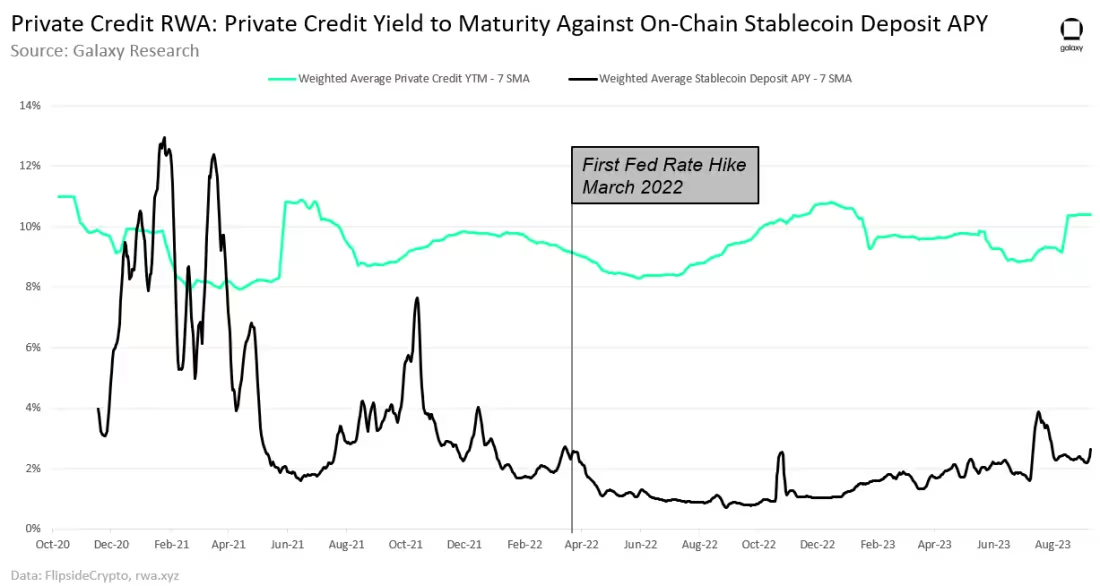
Users can earn significantly higher yields from on-chain private credit loans by depositing stablecoins compared to the yields they would earn using stablecoins through DeFi lending protocols like Aave and Compound. From January 1 to September 30, the average daily interest rate spread between the yield on tokenized private credit loans and the weighted average stablecoin supply rates on Aave and Compound was 7.7%. The stablecoin deposit rates are calculated based on the weighted average of the amounts borrowed against the following assets on Aave and Compound:
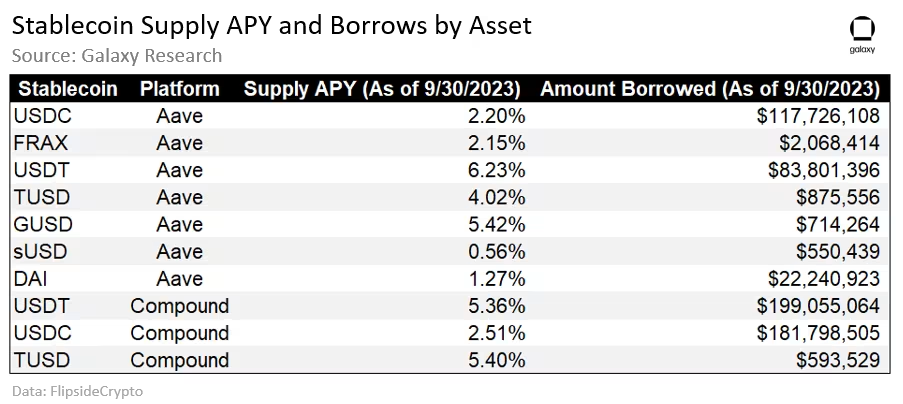
It is worth noting that there are different risk profiles between depositing stablecoins in decentralized lending protocols like Aave and Compound and depositing in platforms like Centrifuge and Clearpool that offer tokenized real-world private credit loans. While most loans on decentralized lending protocols are over-collateralized, the tokens for private credit loans may not be.
Real Estate
Real estate is a tangible asset class that includes properties such as residential, commercial buildings, and land. Real estate is particularly attractive to investors due to its potential to generate positive cash flow through passive income streams like rent. In 2023, real estate is the largest asset class in the world, valued at approximately $613 trillion.
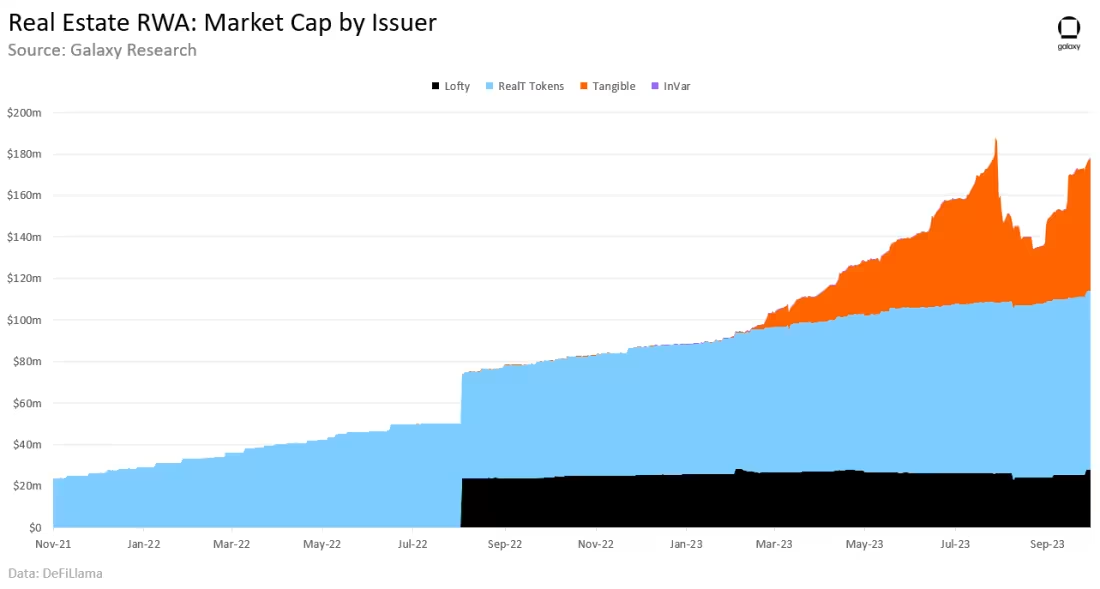
Among all income-generating RWA categories covered in this report, on-chain real estate has seen the least growth in dollar terms. From January 1 to September 30, the total value of these tokenized assets was $178 million, in some cases representing fractional ownership of real estate. RealT tokens are the largest issuer of tokenized real estate, holding a 49% market share. Tangible is another RWA issuer focused on real estate, showing the strongest growth this year. The total value locked in Tangible tokens grew from $100,000 to $64 million in the first three quarters of 2023.
Treasury Bonds and Other Bonds
U.S. Treasury bonds are debt securities backed by the government. They are widely regarded as the safest and most reliable type of income-generating asset, known globally as "risk-free" (it should be noted that the risk is the possibility of U.S. government default). In contrast, corporate bonds are debt securities issued by companies, which may offer higher yields but come with greater risks than Treasury bonds. In 2022, the global bond market was valued at $133 trillion, with U.S. corporations issuing $1.02 trillion in corporate bonds in the first three quarters of 2023 alone.
The value of tokenized Treasury bonds and other bonds increased by $557.05 million from January 1 to September 30. Ondo Finance, Franklin Templeton, and Matrixdock are the top three issuers of Treasury bond RWAs. Together, they have issued $572.05 million in assets (accounting for 85% of the tokenized Treasury bonds and other bond categories) and issued $468.5 million in Treasury bond RWAs this year.
Frigg.eco differs from other issuers in this category by issuing bonds related to sustainable infrastructure developers. These instruments are more akin to corporate bonds rather than Treasury bond RWAs issued by others. The bonds issued by Frigg.eco allow token holders to earn returns by funding developments and allow developers to issue debt to finance their initiatives.
Another tokenized Treasury asset valued at approximately $1.8 billion is stUSDT. stUSDT is the first RWA project launched on the Tron network. Recently, this asset has faced criticism for its lack of transparency regarding its backing and sources of yield.
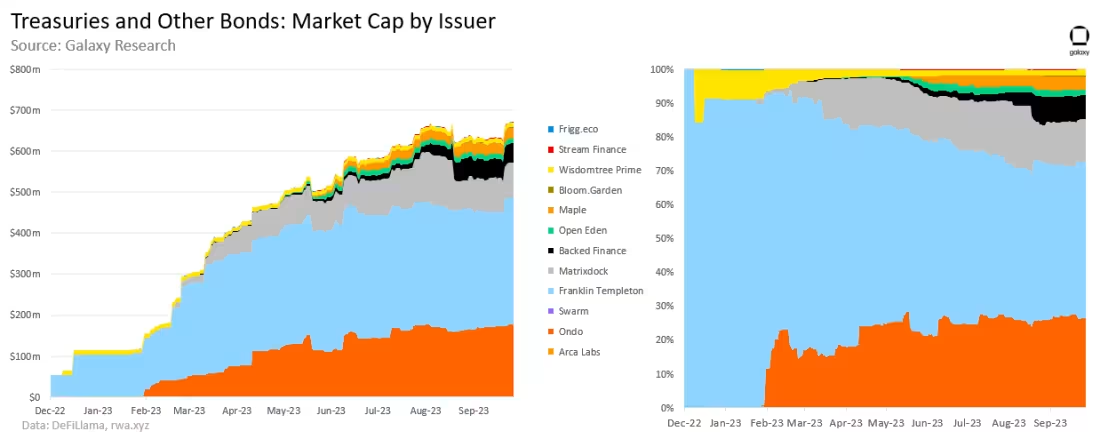
Over the past 18 months, the average yield on U.S. Treasury bonds with maturities of less than 3 years (the most widely adopted maturity on-chain) has consistently been higher than the average yield on stablecoin deposits. In 2023, the average yield on these Treasury bonds compared to the weighted average stablecoin rates on Aave and Compound had an average daily interest rate spread of about 3% (Treasury bond yield - on-chain yield). In contrast, the average spread between the yields on Moody's AAA-rated corporate bonds and on-chain stablecoin yields was 2.7% (corporate bond yield - on-chain yield).
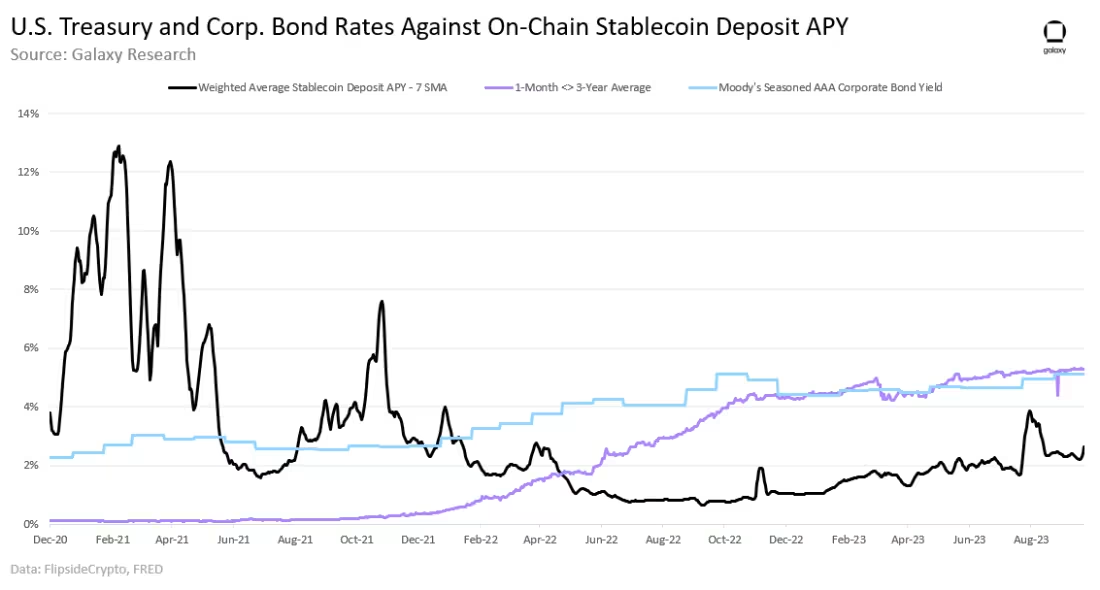
Outlook
The demand for yields from crypto-native users is driving the growth of on-chain RWAs. Approximately 82% of the new value created in the RWA space this year comes from income-generating RWAs such as tokenized private credit, real estate, and Treasury bonds. The share of income-generating RWAs in total RWA market capitalization has nearly doubled from 31% on January 1 to 53% on September 30 (4% away from the historical high of 57%).
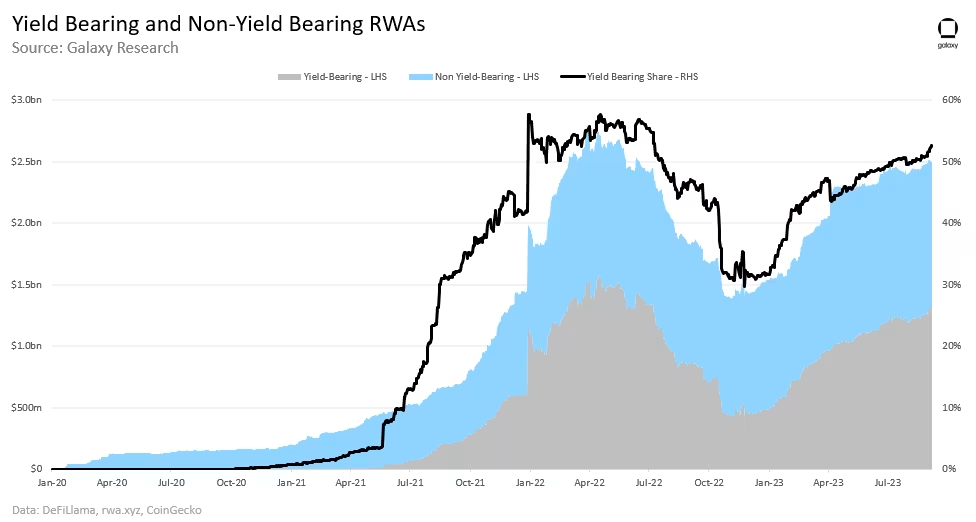
From 2021 to 2023, the Federal Reserve's aggressive shift in monetary policy has raised benchmark interest rates to levels not seen since 2007. This has created new demand from RWA-native decentralized finance users seeking higher yields.
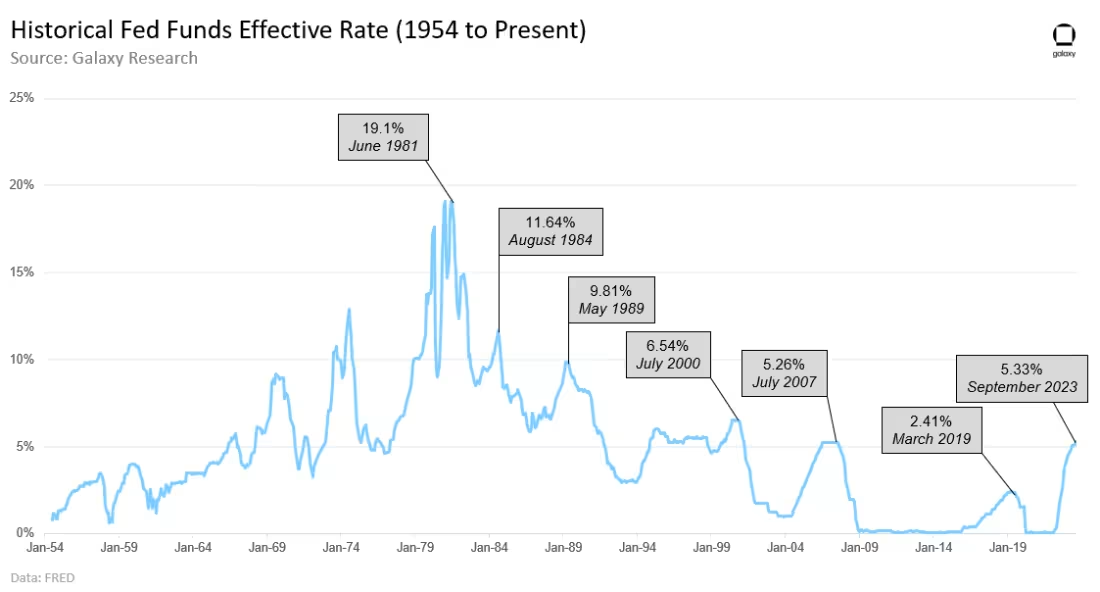
Most RWA Users are Crypto-Native Users
Most of the demand for on-chain RWAs comes from a small number of crypto-native users rather than new crypto adopters or traditional investors. The average user address interacting with RWA tokens was created before these assets were created on-chain, highlighting that the average RWA holder has been trading on-chain for some time.
The following chart shows the age of unique user addresses holding RWA tokens issued by the following companies and protocols. The token symbols for these assets are as follows (in parentheses). These assets collectively account for nearly 70% of the income RWA TVL:
- Ondo (OUSG)
- Matrixdock (STBT)
- Maple (MPLcashUSDT and MPLcashUSDC)
- Open Eden (TBILL)
- Backed (bIB01 and bIBTA)
- Arca Labs (RCOIN)
- WisdomTree (WSTY)
- Swarm (TBONDS13 and TBONDS01)
- Stream Finance (US4W)
- Bloom (TBY-Feb1924, TBY-mar24(a), and TBY-mar24(b))
- Franklin Templeton (FOBXX).
Note: The snapshot of these asset holders was taken on August 31, 2023. Therefore, the age of the addresses is calculated as the number of days between the first on-chain transaction of the address and August 31, 2023. User addresses holding multiple RWAs are counted once. Multiple addresses identified as controlled by a single user are also counted once, using their earliest transaction. The data tracks the age of all on-chain addresses where these assets are issued, including: Ethereum, Stellar, and Polygon. The following data also shows the age of user addresses represented by tokenized private credit issued by the following three protocols:
- Clearpool on Ethereum and Polygon zkEVM
- Maple on Ethereum
- Goldfinch.
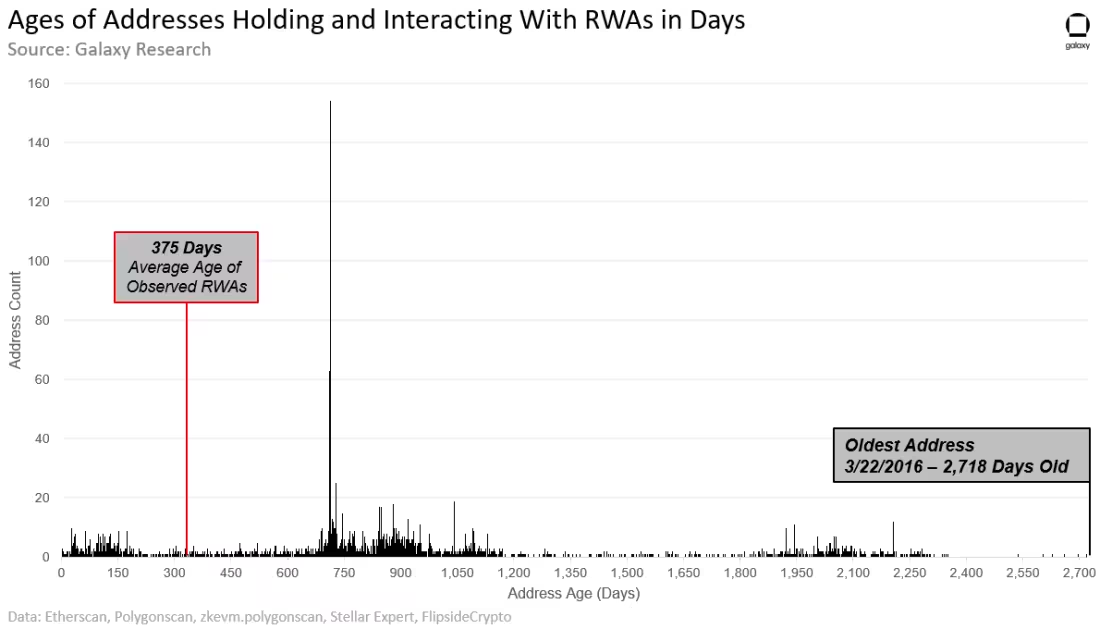
As of August 31, 2023, there were 3,232 unique addresses holding RWA assets issued by the above companies and protocols. The average age of addresses holding and interacting with RWAs is 882 days, or 2.42 years. This means the average address has been on-chain since April 2021. In contrast, the average age of RWA assets is 375 days. For tokenized Treasury assets, the age of these RWAs is calculated as the number of days from the first token minting date to August 31, 2023. For assets issued by private credit platforms like Clearpool, Maple, and Goldfinch, the age is calculated based on the number of days from the protocol launch date to August 31, 2023. For private credit RWA assets, using the protocol launch as the starting date for the age of these assets can compensate for the rolling nature of on-chain private credit (i.e., loan maturity/pool closure, new loans opening).
20% of addresses interacting with or holding the above RWAs began trading on-chain more than three years ago, prior to the rise of RWA assets on-chain in 2023. The following table summarizes the age ranges of user addresses holding RWAs as of August 31, 2023:
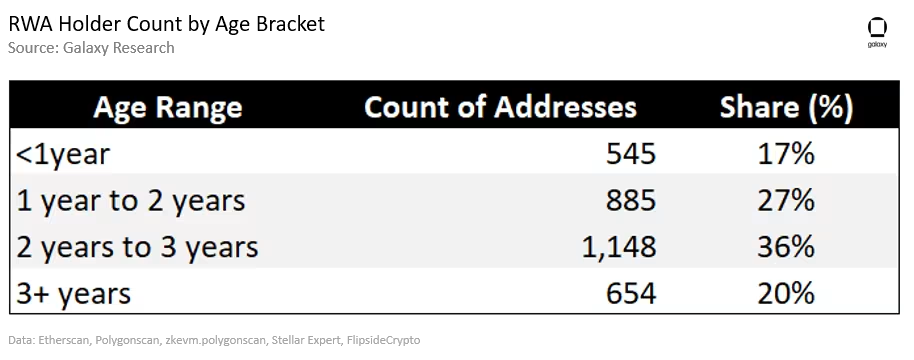
Many of the RWA holders highlighted above, who executed their first transaction less than a year ago, are holders of assets issued by Franklin Templeton and WisdomTree (34%, 188 addresses), indicating that RWA products created by established financial companies may be successfully attracting a new user base into the crypto space, although the majority of RWA users still appear to be crypto-native users.
RWAs Imply Real-World Risks and Limitations
While many RWAs are issued on public blockchains, they do not provide users with unrestricted access to financial products and services. In most cases, users interacting with RWAs on-chain must complete KYC/AML or whitelist verification, credit checks, and may need to meet minimum balance requirements to mint, purchase, deposit, and/or redeem RWAs. RWAs are subject to similar or, in some cases, more restrictions than their traditional financial counterparts. This means that RWAs do not expand access to financial tools by allowing individuals to participate in financial activities they would otherwise be unable to access.
Additionally, RWAs face unique risks beyond the technical risks associated with all on-chain applications and services. For example, since private credit lending is unsecured in traditional finance in some cases, the tokenized expression of private credit loans must also reflect this reality. If an off-chain borrower defaults on their loan, on-chain depositors may lose funds. To compensate for such risks on-chain, RWA private credit issuers must find ways to position assets through risk/reward transfers within the loan risk/reward spectrum and review new loans through transparent governance processes via decentralized autonomous organizations (DAOs).
The Federal Reserve's Policy is Crucial
The actions of the Federal Reserve have significantly propelled the popularity of RWAs this year. As interest rates rise, off-chain yields have become more attractive to on-chain users. Furthermore, as interest rates increase, the most valuable types of RWAs have also changed. For instance, in Q2 2022, private credit-backed RWAs accounted for 56% of total RWA TVL, while U.S. Treasury-backed RWAs accounted for 0%. In Q3 2023, the share of private credit-backed RWAs in total RWA TVL decreased to 18%, while the share of U.S. Treasury-backed RWAs increased to 27%. Federal Reserve policy is a driving force influencing the expansion and layout of the RWA DeFi space.
Conclusion
The growth of RWAs and the introduction of new types of RWAs on-chain are primarily driven by the demand from crypto-native users rather than new crypto adopters. However, the adoption of RWAs by major traditional financial companies like Franklin Templeton and WisdomTree demonstrates the potential of this emerging DeFi space to attract future new users. The momentum for RWAs in 2023 is strong, with many of these assets' market capitalizations trending toward new historical highs. The evolving macro environment will continue to impact the development of this space, as will the ongoing demand for these assets from both native and non-native crypto users.


